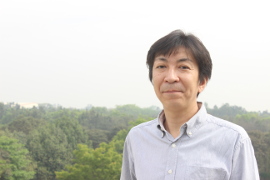Dr. Kouichi Hasegawa (iCeMS) - Specific scientific projects
1. hPSC self-renewal and hiPSC derivation.
hPSCs can unlimitedly self-renew and can maintain their pluripotency and ability to grow in response to stimulation of signaling pathways that control growth. Most of the hPSC self-renewal conditions rely on growth factors such as bFGF and TGFβ. However, the signaling pathways stimulated by these growth factors in hPSC self-renewal are largely unknown. In addition, there are few reports on the roles of other signaling pathways in the self-renewal process. We have previously reported that Wnt pathway induces both hPSC proliferation and differentiation, and that DYRK signaling is involved in the differentiation induced by Wnt. Recently, in collaboration with iCeMS, we have demonstrated hPSC self-renewal independent of bFGF/TGFβ by utilizing three small molecule chemical compounds, thereby generating a defined culture method for hPSC self-renewal. Additionally, the new defined culture media enhanced the efficiency of iPSC derivation from human fibroblasts. Analysis of the small molecule-mediated signaling pathways, revealed that the combination of compounds used modulated the metabolic pathways in hPSCs to favor self-renewal and iPSC derivation. We are in the process of further characterizing the signaling pathways involved in the bFGF/TGFβ-dependent and -independent (our new three compound) culture conditions to understand hPSC self-renewal and iPSC derivation.
2. Malaria – P.vivax liver-stage model
Malaria causative agent P. vivax can remain dormant in patient liver leading to relapses several weeks, months, or years after the primary infection and disease. The biology of such relapsing forms of vivax malaria remain unexplored because of lack of sustainable and reliable model of the liver-stage malaria. This is a major bottleneck in developing and testing antimalarial drugs to target the liver-stage of vivax malaria. Therefore, it is highly desirable to develop uniform and reproducible liver-stage model systems that support the high P. vivax infection efficiency observed in patients. In collaboration with scientists at the National Institute for Malaria Research (NIMR), we are developing a reliable and sustainable malaria P. vivax liver-stage assay suitable for drug screening and study of malaria biology. For this, we have collected blood from P. vivax mono-infected patients, generated iPSCs from the blood cells, and differentiated them into hepatocytes using our newly developed efficient differentiation protocol. Using P. vivax sporozoites harvested in NIMR, we have developed a liver-stage model; although the infection efficiency in this model is still very low. To enhance the infection efficiency, we are currently collaborating with iCeMS to design aligned nano-fiber and micro-patterned plates so as to generate more physiologically relevant liver conditions.
3. Cancer biomarkers and cancer model
Utilizing the similarities between cancer stem cells and hPSC-derived embryonic tissue progenitor cells, we are aiming to discover novel cancer biomarkers for diagnosis and target therapies. Previously, we have identified a novel biomarker for pancreatic ductal adenocarcinoma using hPSCs. The biomarker is able to detect the pancreatic cancer in pathological sections and patient serological samples. However, we recently showed that the antibody raised against this biomarker also detected cholangiocarcinoma and gallbladder cancer cells. Therefore, we are currently exploring the usability of the biomarker in other cancers. Additionally, we have started a new pilot project to develop an early-phase neuroblastoma model to understand cancer initiation and identify new biomarkers for this type of cancer.



